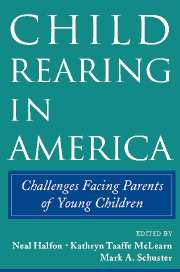Book contents
- Frontmatter
- Contents
- Tables
- Figures
- Contributors
- Acknowledgments
- 1 Introduction and Overview
- PART I CONDITIONS OF FAMILIES WITH YOUNG CHILDREN
- PART II CHILD-REARING PRACTICES
- 4 Meeting the Challenges of New Parenthood: Responsibilities, Advice, and Perceptions
- 5 Reading, Rhymes, and Routines: American Parents and Their Young Children
- 6 Child Discipline in the First Three Years of Life
- 7 Breastfeeding in the United States Today: Are Families Prepared?
- 8 Depressive Symptoms in Parents of Children Under Age 3: Sociodemographic Predictors, Current Correlates, and Associated Parenting Behaviors
- PART III DELIVERY OF HEALTH SERVICES TO MOTHERS AND CHILDREN
- PART IV FUTURE DIRECTIONS AND POLICY IMPLICATIONS
- Index
- References
6 - Child Discipline in the First Three Years of Life
Published online by Cambridge University Press: 15 July 2009
- Frontmatter
- Contents
- Tables
- Figures
- Contributors
- Acknowledgments
- 1 Introduction and Overview
- PART I CONDITIONS OF FAMILIES WITH YOUNG CHILDREN
- PART II CHILD-REARING PRACTICES
- 4 Meeting the Challenges of New Parenthood: Responsibilities, Advice, and Perceptions
- 5 Reading, Rhymes, and Routines: American Parents and Their Young Children
- 6 Child Discipline in the First Three Years of Life
- 7 Breastfeeding in the United States Today: Are Families Prepared?
- 8 Depressive Symptoms in Parents of Children Under Age 3: Sociodemographic Predictors, Current Correlates, and Associated Parenting Behaviors
- PART III DELIVERY OF HEALTH SERVICES TO MOTHERS AND CHILDREN
- PART IV FUTURE DIRECTIONS AND POLICY IMPLICATIONS
- Index
- References
Summary
Since the start of recorded history, students of human development have tried to explain why individual humans grow up to be distinct from each other in their attitudes, emotions, and behaviors. Most explanations have, to a greater or lesser extent, given a role to children's interactions with others–and, in particular, to how parents treat their children. Scholars from many fields have examined child-parent interactions. Human rights and child welfare advocates have focused on children's right to protection from exploitation and interpersonal violence and explored distinctions between fair and abusive parent disciplinary practices (Gil 1970). Political theorists have viewed child discipline as a reflection of strongly held beliefs about appropriate means of fostering human development, beliefs that are in turn reflected in ideals regarding the structure and role of government (Lakoff 1996). Neuroscientists of late have described how brain growth continues actively after birth in a process that relies on input from the child's environment (Sameroff 1997). From their earliest days, children are learning and may be laying down powerful memories–in the form of nearly indelible neural pathways–related to fear, aggression, trust, and nurturing (LeDoux 1996).
APPROACHES TO PARENTAL DISCIPLINE AND PUNISHMENT
The word “discipline” has many meanings and connotations. In its broadest sense, discipline is the collection of acts and rules that parents use to “socialize” their children, to teach them the values and normative behaviors of the society in which they will have to function as adults (Cherlin 1996).
- Type
- Chapter
- Information
- Child Rearing in AmericaChallenges Facing Parents with Young Children, pp. 146 - 177Publisher: Cambridge University PressPrint publication year: 2002
References
- 15
- Cited by



